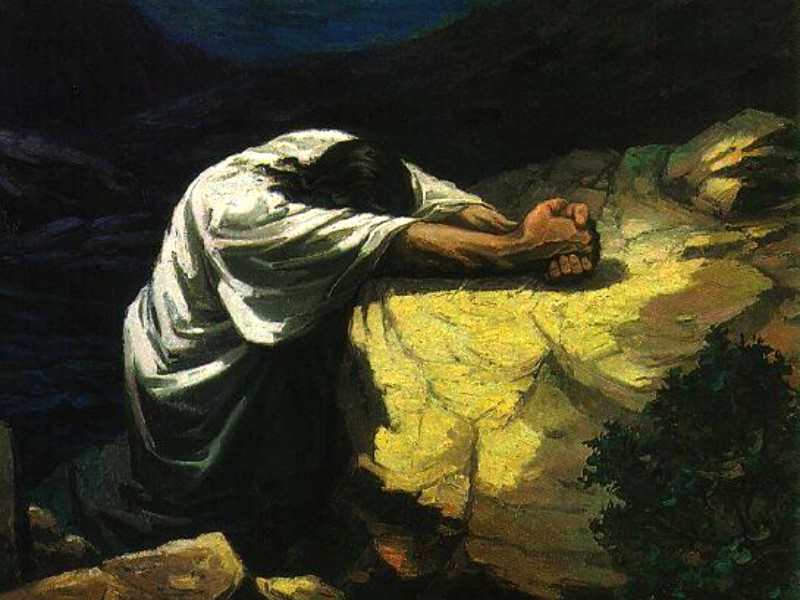
Core: Trinity…Love…Theosis

The purpose of human life is defined by God. God chose to create humans in the way He wanted to, and God created us for a purpose. So: What did God make you to be?
In the image of God
The Bible says we are made in the image of God.
You might begin to think of things like our consciousness, or our reasoning ability, or ability to communicate. These things do make us distinct from the animals.
But what of small children, or those who are mentally damaged? Are they made less than the image of God than you? I certainly don’t think so.
I believe that rather than starting with classical “attributes” of God, we should look at the very nature of God as revealed to us by Jesus Christ. The Bible tells us that Jesus is “the brightness of God’s glory and the express image of His person” (Heb. 1:3), and that He is “the fullness of God in bodily form” (Col. 2:9). Jesus showed us clearly that God is Triune. He showed us that there is the Son of God, the Father, and the Holy Spirit.
This Trinitarian view of God is absolutely unique to Christianity. It is one of the fundamental revelations of the New Covenant.[1]
God is a trinity, and therefore God is inherently relational within His own being. Each member of the Trinity is fully God. The Father and the Son and the Holy Spirit are distinct from the other (the Son is not the Father); yet they are not separate or divided from the other.
One early Christian poem expressed this truth as comparing God to a fire, possessing the flame proper, the light cast, and the heat  proceeding from it. Each is distinct, yet not ‘separate.’ You might consider, as some early Christians did, comparing the Father to an eternal spring, while the Son and Holy Spirit were eternal rivers that flowed from Him. All are of the same ‘essence’, the Son ‘begotten’ from the Father, the Spirit “proceeding” from the Father and “sent” by the Son in a mysterious way, and all eternally and necessarily joined to one another, yet distinct. Because they are all eternal, there never was a time when the Father was without the Son or Holy Spirit.
proceeding from it. Each is distinct, yet not ‘separate.’ You might consider, as some early Christians did, comparing the Father to an eternal spring, while the Son and Holy Spirit were eternal rivers that flowed from Him. All are of the same ‘essence’, the Son ‘begotten’ from the Father, the Spirit “proceeding” from the Father and “sent” by the Son in a mysterious way, and all eternally and necessarily joined to one another, yet distinct. Because they are all eternal, there never was a time when the Father was without the Son or Holy Spirit.
The earliest Christians certainly received this revelation from the Apostles and disciples, who learned it from Jesus and the revelation of the Holy Spirit. We find echoes of it from writings all over the world, as early as the 100’s (second century).
As mentioned, a popular hymn writer (St. Ephrem) wrote the following poem on the
Trinity in 350AD:
The sun serves as our source of illumination and
none can grasp what it is like;
How much more is this the case if we are talking
about human kind and even more so,
If about God.
The light of the sun does not come after the sun,
nor is there any time when it was not;[2]
The sun’s light may be considered as second,
And its heat as third:
They are neither separate from it or identical with it.
REFRAIN: PRAISE TO HIM WHO SENT YOU
FROM ALL WHO BELIEVE IN YOU.
Look at the sun in the sky: it is thought of as one;
lower your gaze and see its light,
A second element; then experience and
feel its warmth, a third.
They resemble one another, and at the same time,
they do not: the second element is commingled in
the sun, yet it is distinct from it; the third element is
mixed with it,
…One resides in the other in a balanced way,
ungrudgingly, mixed together,
But not confused, commingled; yet not bound,
joined together, but not under constraint, at the same
time free, but not divergent.
Let dictatorial people be silenced by what is quite apparent, for here we have one in three
And three in one, commingled, but not fixedly so,
distinct, yet not totally separate.
There is marvel in all this which makes us keep silent.[3]
Loving Relationship as the Core Purpose of Creation
Think of the mysterious union of the Trinity – each “person” of the Trinity is intimately and lovingly involved in the other, never separated or segmented apart. They share fully in the same nature. But at the same time, they maintain their distinct personhood. They can love the other and be indwelt without losing their own personhood and volition.
In very a similar way, you were created to share in God’s divine nature. Peter wrote that Christians are to be “partakers of the divine nature” (2 Pet. 1:4). Not by being a part of the Trinity, of course, but by being invited to partake of God Himself as he comes to dwell in you. When God indwells you, your personality will not be extinguished or consumed. As the Father, Son, and Holy Spirit do not extinguish or consume the other, your personhood (created by God) will be purified and emphasized in the right way as you are brought into communion with the Living God, who is Love. You are invited into the eternal dance of love (perichoresis) shared by the Trinity.
Moses observed a burning bush which was not consumed. We may become a human being
illuminated through with the Fire of God, yet not consumed.
This is what it means to be made in the image of God – or to be remade in the image of God.
The triune relational flow of love is mirrored in you, in your capability (through God’s grace) to receive the inflow of God himself and yet remain a distinct person. Likewise, the relationship of husband and wife was created to foreshadow the love of God for His people (Israel and the Church).
It is no surprise that Jesus’ distilled all of God’s commands into one command of love: Love God, and Love your Neighbor as Yourself. Within the Trinity this has always been so; God graciously creates and invites humankind to yield to that purpose for our lives.
IMAGO DEI
While God is described in many ways in the Bible, John identified Him in 1 John in three ways: God is life, God is light, and God is love.[4]
We humans are individual creatures, yet we are made in the image of the Triune God. I propose this means we are relational in at least three specific ways:
1) fundamentally designed to love,
2) possessing distinct personhood,
3) having the ability (through grace) to yield ourselves to be fully penetrated and filled by God’s presence while remaining distinct from Him (not annihilated or subsumed).
FAMILIAL LOVE
The affectionate title Jesus gives His “Father,” and the Father gives “My Beloved Son,” show the familial love and devotion that the members of the Trinity share. “God is love.” Love, thus, “is the supreme ethic.”[5] Because God is love, this “love has been poured out”[6] from Him into the creation of a world of “other” “persons” who can be invited into this eternal love of the Trinty. The purpose of God’s creation is to invite us – the creatures of whom the Trinity said “Let us make man in our image” – into that familial love. We are invited to come into the peace-filled rest and joy that His uni
ted presence will bring.
 God made the created order to reflect this familial love. God knew that He was going to make the family structure, but He made Adam alone first – simply to pause, declare that such isolated independence was “not good,” – and then “created humanity in His own image, male and female He created them.”
God made the created order to reflect this familial love. God knew that He was going to make the family structure, but He made Adam alone first – simply to pause, declare that such isolated independence was “not good,” – and then “created humanity in His own image, male and female He created them.”
DIVINE TRINITARIAN PERSONHOOD: INTERPENETRATION WITHIN DISTINCTION
As we have seen, the Father, Son, and Holy Spirit exist as one divine Being. They share the same nature, united in “an eternal dance of love”[7]; interconnected with and inseparable from the others.
The members of the Trinity are distinct “Persons”, yet they fully interpenetrate each of the others. In the orthodox Christian understanding there is a relational flow among the Persons. We can begin to grasp the relational connection between these members of the Trinity in Jesus’ words, “I am in the Father, and the Father is in me,” and John’s words, “The Word was with God” (distinct and alongside) “and the Word was God” (fully participating by nature in what it means to be God).
Yet the Son is not the Father, and the Father is not the Son, even though they fully are
“in” each other. The Son can truly say “I have come, not to do my will, but the will of my Father in Heaven,” even though they are also eternally united in purpose. True love and true yieldedness to another requires willingness. (Being in God’s image, as perfectly embodied by the Gorman Jesus Christ, thus implies one is capable of being interpen etrated by God Himself without losing one’s personhood, including one’s personal identity or volition). The Son is not a mask worn by the Father[8]; neither is the Son is the puppet of God, stripped of independent volition. He is indeed a distinct person even though He is both inseparable from the Father and both are completely in the other. Everything the Father is – except for His personal identity as the Father – the Son is: “God of God, Light of Light, very God of very God; begotten, not made, being of one substance with the Father.”
etrated by God Himself without losing one’s personhood, including one’s personal identity or volition). The Son is not a mask worn by the Father[8]; neither is the Son is the puppet of God, stripped of independent volition. He is indeed a distinct person even though He is both inseparable from the Father and both are completely in the other. Everything the Father is – except for His personal identity as the Father – the Son is: “God of God, Light of Light, very God of very God; begotten, not made, being of one substance with the Father.”
Let’s return to the example of flame. We could imagine that we are like an iron bar that God has created. Whether we are in relational union with God or not, we exist. But there is a distinct difference between iron at room temperature, and iron plunged into a white-hot flame. When iron is heated in a fire, it begins to glow and become formable. It retains its own distinct properties, but the fire is ‘filling’ the iron and bringing its qualities into a new kind of state.
HUMANS: CREATED AS PERSONS, CAPABLE OF RECEIVING GOD BY GRACE
We are “created” in the image of God, not eternal members of the Triune God. Therefore, we cannot participate in the love and fellowship of the Trinity automatically, by our nature, but only as recipients of this love, by grace. There are no openings to be filled in the Trinity.
Because we are distinct from the Trinity, we can become participants in this grace only by volitionally yielding our souls to Him as He offers to fill us with Himself. If God were to force Himself upon us, we would no longer be the “others” or the “persons” He created; we would no longer be freely choosing to love Him, our personhood would be subsumed by Him, and our love would be mere compliance and conformity.[9]
In His love, God chose to create beings with whom He could share the best possible gift: the gift of participating in the love and joy that are in Him. For this yieldedness to be possible, He made “persons” in His own image, capable of yielding to His presence volitionally, but not having our volition annihilated or subsumed in the process. God wanted a reciprocal relationship of love and fellowship, not merely beings that He could animate or puppet. God desired genuine, voluntary, deep, intimate love to be shared between Him and His creation.[10]
INCARNATION
The eternal Son of God became man, and in Jesus Christ we find the one being who is both Human (as we are) and God (“the fullness of the Godhead in bodily form” Col.2:9). Because of this, he is “the one mediator between God and man” (1 Tim. 2:5).
In the person of Jesus Christ, we see both God as He truly is, and humanity as it can be by His grace.
In the act of the redemption of mankind, “God was in Christ, reconciling the world to Himself”; even in the very work of the cross (2 Cor. 5:19), and it was “through the eternal Spirit” that Jesus offered Himself as a sacrifice (Heb. 9:14). Jesus Christ as the GodMan is a perfect representation of His Father: He is “the brightness of His glory and the exact representation of His being” (Heb 1:3), Jesus affirmed He only did what He saw the Father doing (John 5:19); Jesus even said “If you have seen me, you have seen the Father” (John 14:9). Even in the Old Testament, “No one has ever seen God [the Father] – the only-begotten of the Father [Jesus], He has revealed Him,” (John 1:18). We affirm Torrance’s thought-provoking statement, “There is no God behind the back of Jesus Christ,” for Jesus perfectly reveals the fullness of God, in bodily form (Col. 2:9).
in Christ, reconciling the world to Himself”; even in the very work of the cross (2 Cor. 5:19), and it was “through the eternal Spirit” that Jesus offered Himself as a sacrifice (Heb. 9:14). Jesus Christ as the GodMan is a perfect representation of His Father: He is “the brightness of His glory and the exact representation of His being” (Heb 1:3), Jesus affirmed He only did what He saw the Father doing (John 5:19); Jesus even said “If you have seen me, you have seen the Father” (John 14:9). Even in the Old Testament, “No one has ever seen God [the Father] – the only-begotten of the Father [Jesus], He has revealed Him,” (John 1:18). We affirm Torrance’s thought-provoking statement, “There is no God behind the back of Jesus Christ,” for Jesus perfectly reveals the fullness of God, in bodily form (Col. 2:9).
THE GLORY OF GOD AND GLORIFICATION IN HIM OF THE BELIEVER
Doing everything in the glory of God can only be realized by union with Jesus Christ through the Holy Spirit, through faith. To glorify Himself most fully, God desires to make us “partakers of the divine nature” (2 Pet. 1:4); to glorify us with Himself: “the glory which You gave Me I have given them, that they may be one just as We are one: I in them, and You in Me; that they may be made perfect in one” (John 17:22). God does not give us His glory apart from Himself, but He does desire to share Himself with us and so to glorify every believer.
It is only in Jesus that this occurs. Salvation is “in Him”, for it is only n Him that we are blessed with “every spiritual blessing…in Christ” (Eph. 1:3), we are chosen “in Him” (Eph 1:4), it is only “in Him [that] we have redemption through His blood,” (Eph 1:7), our inheritance is “in Him” (Eph 1:11), we are “buried with Him” in baptism (Rom. 6:4, Col. 2:12), and likewise “raised with Him through faith” (Col 2:12), so that we “may walk in newness of life” (Rom 6:4), a life characterized not by the demands of the law but by “the newness of the Spirit (Rom. 7:6). Every promise of God finds its “Yes” in Jesus (2 Cor 1:20).
It is the work of the Holy Spirit to communicate to us the treasures hidden in Jesus Christ, and to supernaturally “shine the light of the glory of God in the face of Jesus Christ” into our hearts (Col. 2:3, 2 Cor. 3:18, 4:6). “This is eternal life: that they may know you, the only true God, and Jesus Christ whom you have sent” (John 17:3). The Holy Spirit communes with us and imparts to us this miracle if we will receive it, “so that Christ may dwell in your hearts by faith” (Eph. 3:17). It is only when we are truly filled with Him that we will be “filled with the fruit of righteousness that comes through Jesus Christ–to the glory and praise of God” (Phil 1:11), because this fruit is through Jesus. The fruit of the Spirit will likewise be produced by the Spirit within our heart. This Trinitarian union of loving purpose will be carried out in a miracle of sanctification within your soul, if you will trust God to do it, and surrender to Him utterly and continually. Even this act of surrender is a grace wrought by the Holy Spirit by the mercies of Christ, if we will but ask and let Him perform it.
This being a “partaker of the divine nature” (2 Pet. 1:4), abiding in Jesus like a branch in the vine (John 15:5), shining like the sun (Matt. 13:43), bearing “the image of the heavenly Man” (1 Cor. 15:49), and ultimately being “made like Him” (1 John 3:2) is God’s loving purpose for human life. It is not a gift God gives you apart from Himself, nor could it be. It is “Christ in you, the hope of glory” (Col 1:27). Glorification is not something God does to you – it is something that happens as God dwells in you. Christians in the East have called this “Theosis.”
SUMMARY
Let’s summarize what we covered above.
First, the nature of the Trinity shows that we are created in the image of God, indicating we are designed for relationships of affectionate, familial love.
Second, the Trinity shows that being a “person” in God’s image means we are distinct beings able to be fully interpenetrated by God, while at the same time our individuality and personhood is not subsumed or annihilated by His presence in us.
Third, as creatures we are not a part of the Trinity “by nature.” God creates us as “others”, and He invites us into the loving relationship of the Trinity. As “others” we may participate in it only by His grace, not by nature; as “persons” our participation must be volitional and free; it is not and indeed cannot be either automatic or compulsory or else it would not be true love, true surrender, or true personhood in the image of God.
Finally, this participation is “in Christ.” As we yield in trusting surrender to be continuously led and filled with the Spirit, we will be “transformed from one degree of glory to another”, by the Spirit, through the Person of Jesus Christ, until ultimately we are by grace what Jesus Christ is by nature, for “we shall be like Him, for we shall see Him as He is” (1 John 3:2).
——————————
END NOTES



